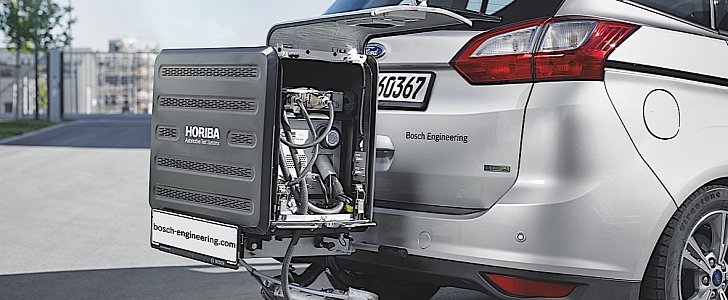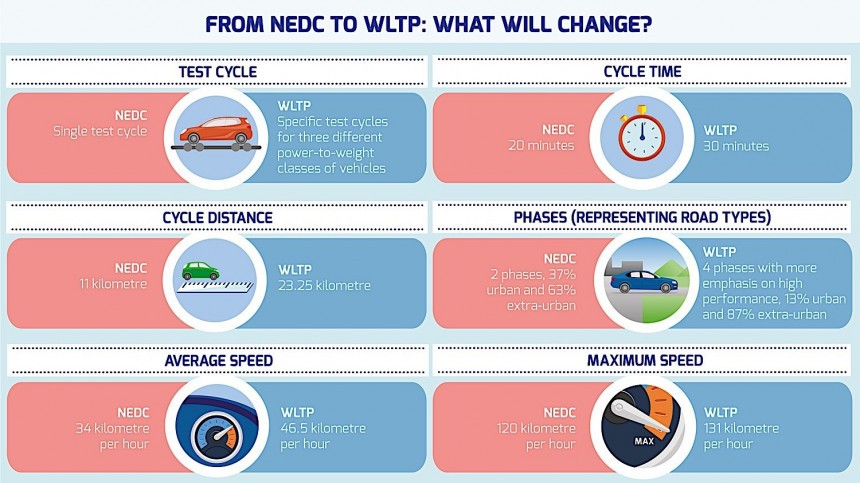With all the commotion caused by Volkswagen and the Dieselgate scandal in recent years, the pressure on carmakers to reduce the levels of harmful pollutants coming from their cars in higher than ever.
One tool in forcing them to create cleaner engines is the emission standard set up to govern how much pollutants engines can emit while in operation. These standards, although not hard to meet, require all automakers to test their engines thoroughly before releasing them onto the market.
There are only a few methods they can use to test the levels of emission of the power plants: they either do laboratory testing, or they go on the road for real-life condition testing.
Until recently, there hasn’t been a global standard for testing car engines. In Europe, carmakers relied on the New European Driving Cycle (NEDC), while the U.S. market got the pulse of emissions through the EPA Federal Test Procedure (FTP).
Now, we have the Worldwide Harmonised Light Vehicle Test Procedure, or WLTP, that in theory could be used on a global scale. The series of laboratory tests (or bench tests, as they are known) that make up WLTP have been created to provide a global tool to see how pollutant, CO2 emissions, and fuel consumption values would be comparable worldwide.
In Europe, the WLTP has already begun replacing since last year the New European Driving Cycle (NEDC) that was implemented in the 1980s and based on theoretical driving.
For each of the models that come off assembly lines, tests are being conducted for the model’s lightest and heaviest versions. The cars are divided into three main classes, depending on the power-to-weight ratio.
WLTP sets up the rules governing the conditions of dynamometer tests and motion resistance. Gear shifting, car weight, fuel quality, ambient temperature, types of tires and their pressure are also taken into account.
When a new car enters the testing phase, it is reviewed for the following values: fuel consumption, CO2 emissions, pollutant emissions, and energy consumption values for alternative powertrains.
The first two values are linked. The amount of CO2 released by a running engine is directly related to the amount of fuel it burns. One gram of CO2 released into the air matches 0.043 liters of fuel burned for every 100 km. That means, for instance, that a car with average fuel consumption of 5.17 liters / 100 km (54 mpg) will release 120 grams of CO2 into the air.
The WLTP is a laboratory test, and despite being more accurate than the defunct NEDC, it still doesn’t provide an accurate measurement of emission values in real-world conditions. For this task carmakers and regulators will use the Real Driving Emissions (RDE) test procedure that complements the WLTP.
RDE step 2, with a NOx maximum level of 1.0 plus an error margin of 0.5, will be implemented in 2020.
The maximum level of NOx emissions are called conformity factors and is the cap by which the Euro 6 NOx emission limit would be allowed to be exceeded in real-world driving.
The main idea behind the RDE is to take a car and test in real road conditions, exposed to a range of different conditions.
Using special equipment mounted inside the car and outside the car - Portable Emission Measuring Systems, or PEMS -, specialists try to make sure the pollutants and CO2 levels do not exceed the limits in the following conditions: low and high altitudes, year-round temperatures, additional vehicle payload, up- and down-hill driving, urban roads at low speeds, rural roads at medium speeds and motorways at high speeds.
Regardless of the way in which tests are being conducted, there is no chance they are 100 percent accurate. What’s more, even if the testing procedures are harmonized, the results of the testing will have to comply with emission standards that are different from region to region.
No testing procedure of any kind, be it bench or real-life, will be able to take into account the individual driving style of the drivers, changes in the type of fuel used, the use of an air conditioning system and so on.
There are only a few methods they can use to test the levels of emission of the power plants: they either do laboratory testing, or they go on the road for real-life condition testing.
Until recently, there hasn’t been a global standard for testing car engines. In Europe, carmakers relied on the New European Driving Cycle (NEDC), while the U.S. market got the pulse of emissions through the EPA Federal Test Procedure (FTP).
Now, we have the Worldwide Harmonised Light Vehicle Test Procedure, or WLTP, that in theory could be used on a global scale. The series of laboratory tests (or bench tests, as they are known) that make up WLTP have been created to provide a global tool to see how pollutant, CO2 emissions, and fuel consumption values would be comparable worldwide.
In Europe, the WLTP has already begun replacing since last year the New European Driving Cycle (NEDC) that was implemented in the 1980s and based on theoretical driving.
WLTP EXPLAINED
There are four parts included in the test, conducted at different average speeds: low, medium, high and extra high. For each of these tests, the car must execute a series of maneuvers, including stop, braking, and acceleration.For each of the models that come off assembly lines, tests are being conducted for the model’s lightest and heaviest versions. The cars are divided into three main classes, depending on the power-to-weight ratio.
WLTP sets up the rules governing the conditions of dynamometer tests and motion resistance. Gear shifting, car weight, fuel quality, ambient temperature, types of tires and their pressure are also taken into account.
When a new car enters the testing phase, it is reviewed for the following values: fuel consumption, CO2 emissions, pollutant emissions, and energy consumption values for alternative powertrains.
The first two values are linked. The amount of CO2 released by a running engine is directly related to the amount of fuel it burns. One gram of CO2 released into the air matches 0.043 liters of fuel burned for every 100 km. That means, for instance, that a car with average fuel consumption of 5.17 liters / 100 km (54 mpg) will release 120 grams of CO2 into the air.
The WLTP is a laboratory test, and despite being more accurate than the defunct NEDC, it still doesn’t provide an accurate measurement of emission values in real-world conditions. For this task carmakers and regulators will use the Real Driving Emissions (RDE) test procedure that complements the WLTP.
RDE EXPLAINED
RDE will be introduced in Europe in 2018, but there is no word on when or if other regions would adopt it. In September 2017 RDE step 1 took effect, requiring a NOx maximum level of 2.1 for all new car types.RDE step 2, with a NOx maximum level of 1.0 plus an error margin of 0.5, will be implemented in 2020.
The maximum level of NOx emissions are called conformity factors and is the cap by which the Euro 6 NOx emission limit would be allowed to be exceeded in real-world driving.
The main idea behind the RDE is to take a car and test in real road conditions, exposed to a range of different conditions.
Using special equipment mounted inside the car and outside the car - Portable Emission Measuring Systems, or PEMS -, specialists try to make sure the pollutants and CO2 levels do not exceed the limits in the following conditions: low and high altitudes, year-round temperatures, additional vehicle payload, up- and down-hill driving, urban roads at low speeds, rural roads at medium speeds and motorways at high speeds.
Regardless of the way in which tests are being conducted, there is no chance they are 100 percent accurate. What’s more, even if the testing procedures are harmonized, the results of the testing will have to comply with emission standards that are different from region to region.
No testing procedure of any kind, be it bench or real-life, will be able to take into account the individual driving style of the drivers, changes in the type of fuel used, the use of an air conditioning system and so on.






